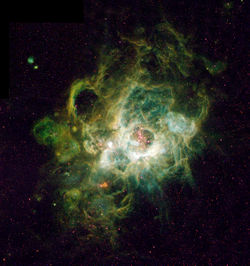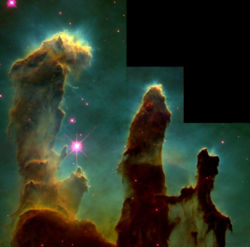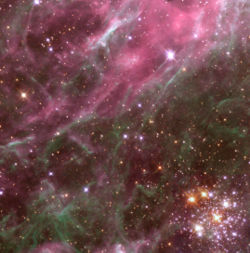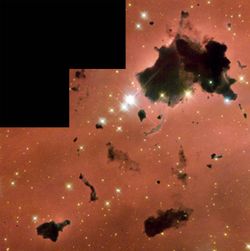H II region
2007 Schools Wikipedia Selection. Related subjects: Space (Astronomy)
An H II region is a cloud of glowing gas and plasma, sometimes several hundred light years across, in which star formation is taking place. Young, hot, blue stars which have formed from the gas emit copious amounts of ultraviolet light, ionising the nebula surrounding them.
H II regions may give birth to thousands of stars over a period of several million years. In the end, supernova explosions and strong stellar winds from the most massive stars in the resulting star cluster will disperse the gases of the H II region, leaving behind a cluster such as the Pleiades.
H II regions are named for the large amount of ionised atomic hydrogen they contain, referred to as H II (pronounced 'aitch two') by astronomers ( H I region ('aitch one') being neutral atomic hydrogen, and H2 (also 'aitch two') being molecular hydrogen). H II regions can be seen out to considerable distances in the universe, and the study of extragalactic H II regions is important in determining the distance and chemical composition of other galaxies.
Observations
A few of the brightest H II regions are visible to the naked eye. However, none seem to have been noticed before the advent of the telescope in the early 17th century. Even Galileo did not notice the Orion Nebula when he first observed the star cluster within it (previously catalogued as a single star, θ Orionis, by Johann Bayer). French observer Nicolas-Claude Fabri de Peiresc is credited with the discovery of the Orion Nebula in 1610. Since that early observation large numbers of H II regions have been discovered in our galaxy and others.
William Herschel observed the Orion Nebula in 1774, and described it as "an unformed fiery mist, the chaotic material of future suns". Confirmation of this hypothesis had to wait another hundred years, when William Huggins (assisted by his wife Mary Huggins) turned his spectroscope on various nebulae. Some, such as the Andromeda Nebula, had spectra quite similar to those of stars, and turned out to be galaxies consisting of hundreds of millions of individual stars. Others looked very different. Rather than a strong continuum with absorption lines superimposed, the Orion Nebula and other similar objects showed only a small number of emission lines . The brightest of these was at a wavelength of 500.7 nanometres, which did not correspond with a line of any known chemical element. At first it was hypothesised that the line might be due to an unknown element, which was named nebulium – a similar idea had led to the discovery of helium through analysis of the Sun's spectrum in 1868.
However, while helium was isolated on earth soon after its discovery in the spectrum of the sun, nebulium was not. In the early 20th century, Henry Norris Russell proposed that rather than being a new element, the line at 500.7 nm was due to a familiar element in unfamiliar conditions.
Physicists showed in the 1920s that in gas at extremely low densities, electrons can populate excited metastable energy levels in atoms and ions which at higher densities are rapidly de-excited by collisions . Electron transitions from these levels in oxygen give rise to the 500.7 nm line. These spectral lines, which can only be seen in very low density gases, are called forbidden lines. Spectroscopic observations thus showed that nebulae were made of extremely rarefied gas.
During the 20th century, observations showed that H II regions often contained hot, bright stars. These stars are many times more massive than the Sun, and are the shortest-lived stars, with total lifetimes of only a few million years (compared to stars like the Sun, which live for several billion years). Therefore it was surmised that H II regions must be regions in which new stars were forming. Over a period of several million years, a cluster of stars will form out of an H II region, before radiation pressure from the hot young stars resulting causes the nebula to disperse. The Pleiades are an example of a cluster which has 'boiled away' the H II region from which it formed – just a trace of reflection nebulosity remains.
Origin and lifetime
The precursor to an H II region is a giant molecular cloud (GMC). A GMC is a very cool (10–20 K) and dense cloud consisting mostly of molecular hydrogen. GMCs can exist in a stable state for long periods of time, but shock waves due to supernovae, collisions between clouds, and magnetic interactions can all trigger the collapse of part of the cloud. When this happens, via a process of collapse and fragmentation of the cloud, stars are born (see stellar evolution for a lengthier description).
As stars are born within a GMC, the most massive will reach temperatures hot enough to ionise the surrounding gas. Soon after the formation of an ionising radiation field, energetic photons create an ionisation front, which sweeps through the surrounding gas at supersonic speeds. At greater and greater distances from the ionising star, the ionisation front slows, while the pressure of the newly ionised gas causes the ionised volume to expand. Eventually, the ionisation front slows to subsonic speeds, and is overtaken by the shock front caused by the expansion of the nebula. The H II region has been born .
The lifetime of an H II region is of the order of a few million years. Radiation pressure from the hot young stars will eventually drive most of the gas away. In fact, the whole process tends to be very inefficient, with less than 10 per cent of the gas in the H II region forming into stars before the rest is blown away. Also contributing to the loss of gas are the supernova explosions of the most massive stars, which will occur after only 1–2 million years.
Stellar nurseries
The actual birth of stars within H II regions is hidden from us by the dense clouds of gas and dust which surround the nascent stars. It is only when the radiation pressure from a star drives away its 'cocoon' that it becomes visible. Before then, the dense regions which contain the new stars are often seen in silhouette against the rest of the ionised nebula — these dark patches are known as Bok globules, after astronomer Bart Bok, who proposed in the 1940s that they might be stellar birthplaces.
Confirmation of Bok's hypothesis had to wait until 1990, when infrared observations finally penetrated the thick dust of Bok globules to reveal young stellar objects within. It is now thought that a typical Bok globule contains about 10 solar masses of material in a region about a light year or so across, and that Bok globules most commonly result in the formation of double or multiple star systems ,,.
As well as being the birth place of stars, H II regions also show evidence for containing planetary systems. The Hubble Space Telescope has revealed hundreds of protoplanetary disks ( proplyds) in the Orion Nebula. At least half the young stars in the Orion Nebula appear to by surrounded by disks of gas and dust, thought to contain many times as much matter as would be needed to create a planetary system like our own.
Characteristics
Physical characteristics
H II regions vary greatly in their physical properties. They range in size from so-called ultra-compact regions perhaps only a light year or less across, to giant H II regions several hundred light years across. Their densities range from over a million particles per cm³ in the ultra-compact H II regions to only a few particles per cm³ in the largest and most extended regions. This implies total masses between perhaps 102 and 105 solar masses.
Depending on the size of an H II region there may be anything up to several thousand stars within it. This makes H II regions much more complicated to understand than planetary nebulae, which have only one central ionising source. Typically, though, H II regions are at temperatures of the order of 10,000 K. They are mostly ionised, and the ionised gas (plasma) can contain magnetic fields with strengths of several tens of microgauss (several nanoteslas). Magnetic fields are produced by moving electric charges in the plasma, and some observations have suggested that H II regions also contain electric fields .
Chemically, H II regions consist of about 90% hydrogen. The strongest hydrogen emission line at 656.3 nm gives H II regions their characteristic red colour. Most of the rest of an H II region consists of helium, with trace amounts of heavier elements. Across the galaxy, it is found that the amount of heavy elements in H II regions decreases with increasing distance from the galactic centre. This is because over the lifetime of the galaxy, star formation rates have been greater in the denser central regions, resulting in greater enrichment of the interstellar medium with the products of nucleosynthesis.
Numbers and distribution
H II regions are found only in spiral galaxies like our own and irregular galaxies. They are never seen in elliptical galaxies. In irregular galaxies, they may be found throughout the galaxy, but in spirals they are almost invariably found with the spiral arms. A large spiral galaxy may contain thousands of H II regions.
The reason H II regions are not seen in elliptical galaxies is that ellipticals are believed to form through galaxy mergers. In galaxy clusters, such mergers are frequent. When galaxies collide, individual stars almost never collide, but the GMCs and H II regions in the colliding galaxies are severely agitated. Under these conditions, enormous bursts of star formation are triggered, so rapid that most of the gas is converted into stars rather than the normal 10 per cent or less. Galaxies undergoing such rapid star formation are known as starburst galaxies. The post-merger elliptical galaxy has a very low gas content, and so H II regions can no longer form.
Recent observations have shown that a very small number of H II regions exist outside galaxies altogether. These intergalactic H II regions are likely to be the remnants of tidal disruptions of small galaxies .
Morphology
H II regions come in an enormous variety of sizes. Each star within an H II region ionises a roughly spherical region - known as a Strömgren sphere - of the gas surrounding it, but the combination of ionisation spheres of multiple stars within an H II region and the expansion of the heated nebula into surrounding gases with sharp density gradients results in complex shapes. Supernova explosions may also sculpt H II regions. In some cases, the formation of a large star cluster within an H II region results in the region being hollowed out from within. This is the case for NGC 604, a giant H II region in the Triangulum Galaxy.
Notable H II regions
Within our galaxy, the best known H II region is the Orion Nebula, which lies at a distance of about 1,500 light years. The Orion Nebula is part of a GMC which, if it were visible, would fill most of the constellation of Orion. The Horsehead Nebula and Barnard's Loop are two other illuminated parts of this cloud of gas.
The Large Magellanic Cloud, a satellite galaxy of the Milky Way, contains a giant H II region called the Tarantula Nebula. This nebula is much bigger than the Orion Nebula, and is forming thousands of stars, some with masses of over 100 times that of the sun. If the Tarantula Nebula was as close to Earth as the Orion Nebula, it would shine about as brightly as the full moon in the night sky. The supernova SN 1987A occurred in the outskirts of the Tarantula Nebula.
NGC 604 is even larger than the Tarantula nebula at about 1,300 light years across, although it contains slightly fewer stars. It is one of the largest H II regions in the Local Group.
Current issues in studies of H II regions

In common with planetary nebulae, determinations of the abundance of elements in H II regions are subject to some uncertainty. There are two different ways of determining the abundance of metals (that is, elements other than hydrogen and helium) in nebulae, which rely on different types of spectral lines, and large discrepancies are sometimes seen between the results derived from the two methods. Some astronomers put this down to the presence of small temperature fluctuations within H II regions; others claim that the discrepancies are too large to be explained by temperature effects, and hypothesise the existence of cold knots containing very little hydrogen to explain the observations .
The full details of massive star formation within H II regions are not yet well known. Two major problems hamper research in this area. First, the distance from Earth to large H II regions is considerable, with the nearest H II region being over 1,000 light years away; other H II regions are several times that distance away from Earth. Secondly, the formation of these stars is deeply obscured by dust, and visible light observations are impossible. Radio and infrared light can penetrate the dust, but the youngest stars may not emit much light at these wavelengths.




